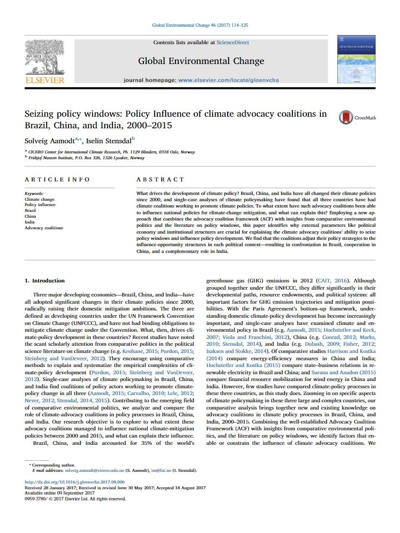Publication: Seizing policy windows: Policy Influence of climate advocacy coalitions in Brazil, China, and India, 2000–2015
To download the publication please click on the download link at the bottom of the page
Authors: Solveig Aamodt, Iselin Stensdal
CNARC member: Fridtjof Nansen Institute (FNI)
Introduction: Three major developing economies—Brazil, China, and India—have all adopted significant changes in their climate policies since 2000, radically raising their domestic mitigation ambitions. The three are defined as developing countries under the UN Framework Convention on Climate Change (UNFCCC), and have not had binding obligations to mitigate climate change under the Convention. What, then, drives climate- policy development in these countries? Recent studies have noted the scant scholarly attention from comparative politics in the political science literature on climate change (e.g. Keohane, 2015; Purdon, 2015; Steinberg and VanDeveer, 2012). They encourage using comparative methods to explain and systematize the empirical complexities of climate- policy development (Purdon, 2015; Steinberg and VanDeveer, 2012). Single-case analyses of climate policymaking in Brazil, China, and India find coalitions of policy actors working to promote climatepolicy change in all three (Aamodt, 2015; Carvalho, 2010; Lele, 2012; Never, 2012; Stensdal, 2014, 2015). Contributing to the emerging field of comparative environmental politics, we analyze and compare the role of climate-advocacy coalitions in policy processes in Brazil, China, and India. Our research objective is to explore to what extent these advocacy coalitions managed to influence national climate-mitigation policies between 2000 and 2015, and what can explain their influence.
Brazil, China, and India accounted for 35% of the world’s greenhouse gas (GHG) emissions in 2012 (CAIT, 2016). Although grouped together under the UNFCCC, they differ significantly in their developmental paths, resource endowments, and political systems: all important factors for GHG emission trajectories and mitigation possibilities. With the Paris Agreement’s bottom–up framework, understanding domestic climate-policy development has become increasingly important, and single-case analyses have examined climate and environmental policy in Brazil (e.g. Aamodt, 2015; Hochstetler and Keck, 2007; Viola and Franchini, 2012), China (e.g. Conrad, 2012; Marks, 2010; Stensdal, 2014), and India (e.g. Dubash, 2009; Fisher, 2012; Isaksen and Stokke, 2014). Of comparative studies Harrison and Kostka (2014) compare energy-efficiency measures in China and India; Hochstetler and Kostka (2015) compare state–business relations in renewable electricity in Brazil and China; and Surana and Anadon (2015) compare financial resource mobilization for wind energy in China and India. However, few studies have compared climate-policy processes in these three countries, as this study does. Zooming in on specific aspects of climate policymaking in these three large and complex countries, our comparative analysis brings together new and existing knowledge on advocacy coalitions in climate policy processes in Brazil, China, and India, 2000 2015. Combining the well-established Advocacy Coalition Framework (ACF) with insights from comparative environmental politics, and the literature on policy windows, we identify factors that enable or constrain the influence of climate advocacy coalitions. We employ the ACF’s main analytical concepts in a new comparative context, and provide feedback on its applicability in comparative studies of large developing countries, a research need highlighted by the ACF’s own developers (Henry et al., 2014).
Our qualitative comparative analysis of primary and secondary data sources shows that climate coalitions in all three countries were influential in the initial development of comprehensive climate policies— also in Brazil, despite heavy opposition from established agribusiness and energy-sector coalitions. External subsystem parameters like political economy and institutional structures are crucial for explaining the coalitions’ policy influence and the endurance of policy change. Climate coalitions appear to adjust their policy strategies to the influence- opportunity structures in each political context, resulting in confrontation in Brazil, cooperation in China, and a complementary role in India.


